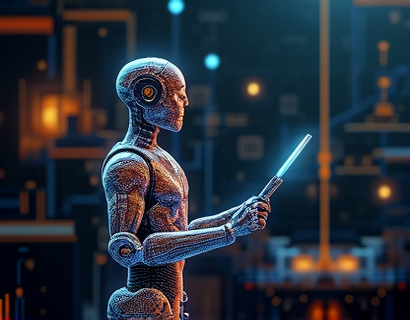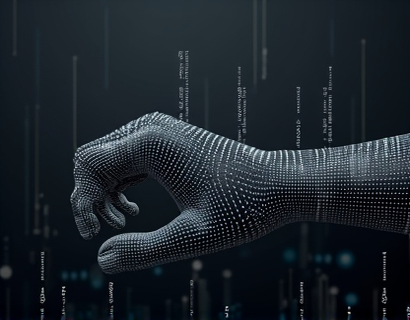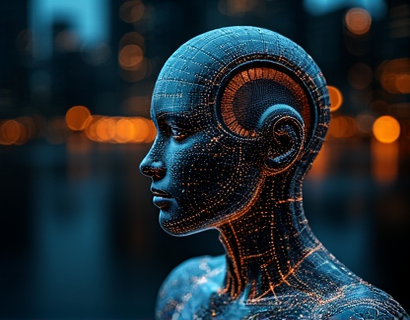Revolutionizing Digital Engagement: The Synergy of Crypto and AI
The intersection of cryptocurrency and artificial intelligence (AI) is ushering in a new era of digital engagement, offering tech innovators and early adopters unprecedented opportunities to enhance their online presence and access advanced applications. This convergence is not just a technological marvel but a transformative force that is redefining how we interact with digital platforms and services. By leveraging the unique properties of blockchain technology and the computational prowess of AI, developers and businesses can create more secure, efficient, and personalized digital experiences.
The integration of crypto and AI is particularly significant for tech-savvy innovators and early adopters who are always on the lookout for cutting-edge solutions. These individuals recognize the potential of this synergy to revolutionize various aspects of digital engagement, from content creation and distribution to user interaction and data management. In this article, we will explore the advanced solutions that emerge from the fusion of cryptocurrency and AI, providing insights into how these technologies can elevate online presence and streamline access to innovative applications.
Understanding the Basics: Cryptocurrency and AI
To fully appreciate the impact of crypto and AI on digital engagement, it's essential to understand the fundamental concepts of each technology.
Cryptocurrency, often referred to as digital or virtual currency, operates on a decentralized network known as a blockchain. This technology ensures transparency, security, and immutability of transactions without the need for intermediaries like banks. The most well-known cryptocurrency, Bitcoin, was the first to demonstrate the potential of blockchain, but numerous other cryptocurrencies have since emerged, each with unique features and use cases.
Artificial intelligence, on the other hand, involves the simulation of human intelligence processes by machines, particularly computer systems. These processes include learning (the acquisition of information and rules for using it), reasoning (using rules to reach approximate or definite conclusions), and self-correction. AI technologies such as machine learning, natural language processing, and computer vision are rapidly advancing, enabling more sophisticated and autonomous systems.
The combination of these two technologies creates a powerful toolkit for developers and businesses. Cryptocurrency provides a secure and decentralized means of transaction and data storage, while AI offers intelligent solutions for data analysis, content generation, and user interaction. Together, they can create a more robust and dynamic digital ecosystem.
Enhancing Security with Crypto and AI
One of the most significant benefits of integrating crypto and AI is the enhancement of security measures in digital platforms. Traditional online systems are vulnerable to various security threats, including hacking, data breaches, and fraud. By leveraging blockchain technology, these risks can be significantly mitigated.
Blockchain's decentralized nature means that data is stored across a network of computers rather than in a central location. This distribution makes it extremely difficult for malicious actors to alter or steal information. Additionally, AI can be employed to monitor and analyze network activity in real-time, detecting and responding to potential threats with unprecedented speed and accuracy. Machine learning algorithms can identify patterns and anomalies that might indicate a security breach, allowing for proactive measures to be taken.
For tech innovators, this means building platforms that are not only secure but also trustworthy. Users are increasingly concerned about the safety of their data, and by incorporating crypto and AI, developers can address these concerns head-on. This not only enhances user confidence but also opens up new markets and use cases that require high levels of security.
Personalization Through AI-Driven Insights
Another area where crypto and AI converge to revolutionize digital engagement is personalization. AI algorithms can analyze vast amounts of user data to provide tailored experiences, recommendations, and content. When combined with the transparency and ownership features of cryptocurrency, this personalization can be taken to new heights.
For instance, AI can be used to create personalized digital wallets that adapt to a user's spending habits and preferences. These wallets can automatically suggest transactions, investments, or savings based on real-time data analysis. Moreover, blockchain ensures that user data is securely stored and managed, giving users greater control over their information.
In the context of content consumption, AI-driven recommendation systems can curate personalized feeds for users, ensuring they see content that aligns with their interests. This not only improves user satisfaction but also increases engagement and retention. By leveraging blockchain, these recommendations can be verified and rewarded, creating a more interactive and incentivized ecosystem.
Streamlining User Interaction with Smart Contracts
Smart contracts, self-executing contracts with the terms directly written into code, are another key component of the crypto and AI synergy. These contracts automatically enforce and execute agreements when predefined conditions are met, eliminating the need for intermediaries and reducing transaction costs and delays.
In digital engagement, smart contracts can streamline various processes, from content monetization to user verification and access control. For example, creators can use smart contracts to automatically distribute royalties to contributors based on predefined criteria, ensuring fair compensation and reducing administrative overhead. AI can enhance this process by analyzing user behavior and preferences to optimize content distribution and monetization strategies.
Furthermore, AI-powered chatbots and virtual assistants can interact with users, guiding them through the platform and resolving issues in real-time. These AI-driven interfaces can be integrated with smart contracts to provide seamless and secure user experiences. For instance, a user could interact with a chatbot to request access to premium content, and the smart contract would automatically verify the user's eligibility and process the transaction.
Data Ownership and Privacy
The integration of crypto and AI also addresses critical issues related to data ownership and privacy. In the current digital landscape, users often have little control over their personal data, which is frequently exploited by companies for profit. Blockchain technology, combined with AI, offers a solution to this problem by giving users greater ownership and control over their data.
AI can help manage and secure user data on the blockchain, ensuring that it is stored and accessed in a privacy-preserving manner. Users can grant or revoke access to their data as needed, and AI algorithms can anonymize or encrypt sensitive information to protect user privacy. This approach not only empowers users but also builds trust in digital platforms.
Moreover, the use of decentralized identity systems, powered by blockchain and AI, allows users to create and manage their digital identities securely. These identities can be used across multiple platforms, eliminating the need for multiple usernames and passwords and reducing the risk of identity theft.
Innovative Business Models
The convergence of crypto and AI opens up new business models that can transform the way companies operate and generate revenue. One such model is the tokenized economy, where tokens represent value and can be used for various purposes within a platform ecosystem.
AI can play a crucial role in managing and optimizing these tokenized economies. For example, AI algorithms can predict market trends, optimize token pricing, and manage supply and demand dynamics. Smart contracts can automate the issuance, trading, and redemption of tokens, ensuring transparency and fairness. This creates a more dynamic and responsive economic system that can adapt to changing conditions in real-time.
For tech innovators, this means exploring new revenue streams and business opportunities. By leveraging tokenized economies and AI-driven insights, companies can create more engaging and rewarding experiences for their users, fostering loyalty and driving growth.
Challenges and Considerations
While the potential of crypto and AI in digital engagement is immense, there are several challenges and considerations that must be addressed. One of the primary concerns is regulatory compliance. The crypto space is still largely unregulated, and the integration of AI adds another layer of complexity. Developers and businesses must navigate varying legal frameworks and ensure that their solutions comply with relevant regulations.
Another challenge is the technical expertise required to implement and maintain these advanced systems. Building a robust crypto and AI infrastructure demands a high level of skill and knowledge. Companies need to invest in training and hiring professionals who can effectively manage and innovate within this domain.
Additionally, there is the issue of user adoption. While early adopters are eager to explore new technologies, the general public may be more cautious. Educating users about the benefits and security features of crypto and AI-driven solutions is crucial for widespread adoption.
Conclusion
The convergence of cryptocurrency and artificial intelligence is poised to revolutionize digital engagement, offering tech innovators and early adopters a wealth of advanced solutions. By enhancing security, personalizing user experiences, streamlining interactions, and creating innovative business models, this synergy is transforming the digital landscape. As the technology continues to evolve, the potential for further advancements and applications is vast. For those who embrace this convergence, the future of digital engagement looks brighter and more promising than ever.










































